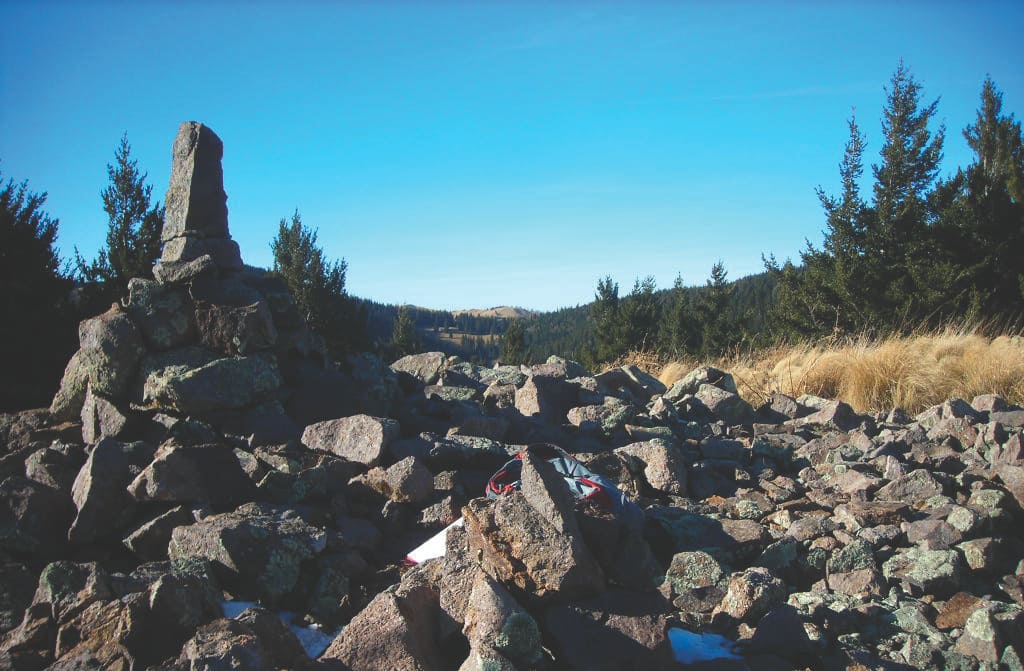The Destruction of Wizard’s Roost

Some properties on the National Register of Historic Places are listed as “address restricted.” Many of these properties are archeological finds and their restricted status is meant to protect them from vandals who might scavenge valuable artifacts. Unfortunately, in the case of Wizard’s Roost, a prehistoric solstice observatory located in Lincoln County, such secrecy did not protect the site. Sometime in the late 1980s, a person or persons unknown scattered the stones that signaled stellar alignments used thousands of years ago. Wizard’s Roost, however, still remains on the register as an area of significance for agriculture during the period of 100 B.C. to A.D. 900.
The person most responsible for finding and documenting Wizard’s Roost is Pete Eidenbach, a well-known historian, anthropologist and NMSU-Alamogordo professor. Working with Human Systems Research, a not-for-profit organization with an office in Tularosa, and as part of a study for the BIA in 1977, Eidenbach and his colleagues accidently discovered two observatories, one on the Lincoln National Forest and one on the Mescalero Apache Reservation. His findings were published in a report titled: “Two Prehistoric Solstice Observatories in the Sacramento Mountains, Southern New Mexico.” This article draws from this report as well as the National Register nomination.
Wizard’s Roost is unique for a variety of reasons. One is the altitude. At 10,363 feet, the site gives an unobstructed view of mountain peaks. Its agricultural significance is not as a place for growing crops, but in its importance as a calendar. For a civilization dependent on crops, knowing when the first frost and summer rains might occur is crucial, especially at higher elevations where growing seasons are shorter and more tenuous.
While other astronomically-aligned structures exist elsewhere, typically near populated areas, Eidenbach noted that Wizard’s Roost is uniquely isolated. It is not on an obviously high point like Sierra Blanca, but, rather, on the top of a much lower ridge. The site itself is nothing but a group of three cairns and a small rock room using dry-laid stone masonry techniques, surrounded by some stunted trees and a glacial debris field.
When Eidenbach and his crew traveled to Wizard’s Roost on the winter solstice to test their theory that the site had calendric significance, they found that the rising and set points “…were closer in alignment than predicted by geometry and magnetic compass.”
Charles Hyder, another investigator, found that, in addition to the winter solstice, one alignment could have been on Sirius, the Dog Star. Using Sirius became important in dating the site. Since the earth oscillates on its axis, moving in a measurably western direction, it is possible to use the difference between where a star rises today and where rocks were positioned to view the same event then to go back to a possible construction date. Calculations lead he researchers to hypothesize that Wizard’s Roost was built 1,500 to 2,000 years ago during the Late Archaic-Early Mogollon period.
Eidenbach also found that other observatories using area mountain peaks might also be present. Working on this assumption, another observatory was found near Pajarito Peak.
While classified as restricted, both sites were added to the New Mexico Space Trail and the New Mexico Museum of Space History in Alamogordo continues to disseminate information regarding the state’s archao-astronomy locations, including Wizard’s Roost.